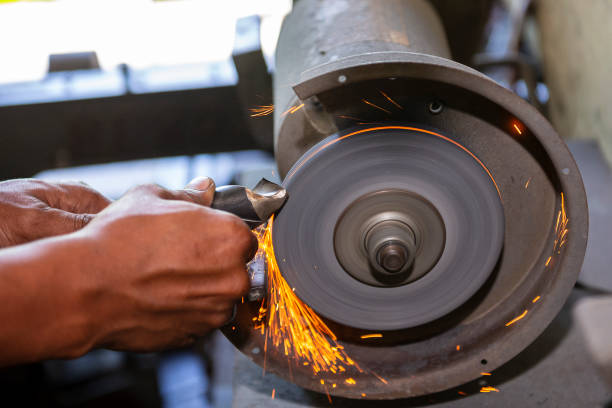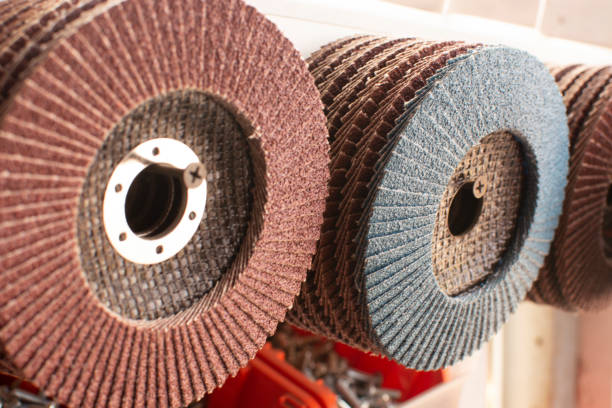Plenty of manual cutting applications call for a hand-held grinder and cutting wheel. Cutting sheet metal, sizing a piece for fabrication, cutting out a weld to re-fabricate it, and cutting and notching in pipeline work are just a few examples of what can be accomplished using a grinder and cutting wheel.
Resinoid-bonded cutting wheels are a popular choice to achieve these types of cuts because they offer portability and allow you to cut in many different angles and orientations. The bonding agent, in this case resinoid, holds the abrasive wheel together so it can cut effectively. The bond wears away as the abrasive grains wear and are expelled so new sharp grains are exposed. By following a few best practices, you can extend wheel life, promote safety, and improve productivity and efficiency within the process.
The Basics of Cutting Wheels
The main considerations in using resinoid-bonded wheels include the cutting application, the tool being used—such as a right-angle grinder, die grinder, or chop saw—desired cutting action, the material being cut, and space. Wheels typically provide a fast-cutting action, long life, and tend to be cost-effective.
The two main types of resinoid-bonded abrasive cutting wheels are Type 1, which is flat, and Type 27, which have a raised hub.
- Type 1 wheels generally are used for straight-on cutting on electric or pneumatic right-angle grinders or die grinders and chop saws, among other tools.
- Type 27 wheels are required when there is some type of interference and the abrasive wheel needs to be raised from the base of the grinder, but personal preference also plays a role in the decision.
They are most commonly used with electric or pneumatic right-angle grinders.
Resinoid-bonded abrasive cutting wheels are available in various sizes and thicknesses. The most popular range is 2 to 16 inches in diameter, and common thicknesses are from 0.045 in. to 1⁄8 in. Thinner wheels remove less material during the cut.
Some types of wheels cut faster than others. The abrasive material used in the abrasive wheel is one influencer on cut-rate and consumable life. Wheels come in several grain options, such as aluminum oxide, silicon carbide, zirconia alumina, ceramic alumina, and combinations of these materials.
While not as sharp as other grains, aluminum oxide provides toughness and good performance for cutting on steel. Silicon carbide, on the other hand, is a very sharp grain but not quite as tough, making it suitable for cutting nonferrous metals. Zirconia alumina is a self-sharpening, tough, durable grain that holds up well in a range of demanding applications. Ceramic alumina also is designed to self-sharpen as it “breaks” at predetermined points to maintain a consistent cut rate and long life.
When selecting a resinoid-bonded abrasive wheel, consider that products made with a mixture of zirconia or ceramic alumina with a harder bond typically cost more but offer durability and longer consumable life.
Make sure to refer to the manufacturer’s recommendations, product descriptions, and RPM ratings to select the proper wheel size and bonded abrasive material for your application. Matching the size and RPM rating of the tool to the size and RPM rating of the abrasive wheel is critical for safe and effective usage. Choosing the tool with the greatest amperage or amount of torque while staying within the size and RPM requirements of the abrasive wheel will increase performance.
The kind of tool and the tool guard that you use also are factors that play a role in the type of wheel that can be used for an application. A larger-diameter wheel works best if you’re cutting deep into metal or need to cut a piece with a large diameter, for example, because it eliminates the need to rock the wheel back and forth during the cutting process. Look for a wheel with a diameter designed for the size and thickness of the material being cut. Thin wheels, on the other hand, tend to remove less metal during the cut and have shorter life spans, but provide a quicker cut.
There are some exceptions to this as different versions of thin wheels are lasting longer, so be sure to do your research before you make a final decision to ensure the abrasive wheel you select maximizes efficiency.
Specialty cutting wheels are also available that are designed for use with certain materials, such as stainless steel and aluminum.
Proper Positioning and Other Tips
In addition to paying attention to designations for RPM rating, size, and material, you should also follow these tips when using resinoid-bonded abrasive cutting wheels.
- Use the cutting wheel at a 90-degree angle, perpendicular to the work surface.
- Apply the proper amount of pressure—not too much, not too little—to allow the cutting wheel to do the work. Always avoid pushing too hard on the abrasive wheel, which can cause the grinder to stall or kick back or give you a much less efficient cutting action. It also increases the chances that you will slip or lose control of the tool, which can cause damage or injury.
- Choose a grinder with the highest torque or amperage available for the application, as this will help the abrasive wheel to do more of the work. For example, instead of using a 4.5-in. the abrasive wheel on a 6-amp grinder, use a 4.5-in. wheel on a 10-amp grinder. The RPM rating remains the same, but the tool will provide more torque to cut into the metal.
- Choose a tool and consumables that offer quick, consistent cutting, which typically provides the most efficient performance.
- Remember, the thinner the cutting wheel, the more susceptible it can be to sideloading, which is a term that describes when the abrasive wheel bends while moving side to side in the cut. This can turn dangerous if you lean too hard on a wheel, which can cause the abrasive wheel to break or jam in the cut. It can also reduce the efficiency of the abrasive wheel and increase the cut time.
- Store the abrasive wheel in a clean, dry environment, and avoid placing it in water or mud. This helps minimize environmental effects that could degrade its performance or cause it to crack or wear prematurely. The performance of the resinoid bond tends to deteriorate when the wheel is stored for extended periods, so be sure to use FIFO (first in, first out) when using wheels.Inspect the wheel and consumables before each use to check for signs of damage or wear. Cutting wheels can become harder to control as they wear down. If you can no longer make a safe cut because the wheel’s diameter is worn so thin, then the best course of action is to replace it.



Hi there! This is my first visit to your blog! We are a collection of volunteers and starting a new initiative in a community in the same niche. Your blog provided us useful information to work on. You have done a extraordinary job!